
(Photos © J. Maus/BikePortland)
With interest in earthquake preparedness at an all-time high, the timing could not have been better for the fourth annual Disaster Relief Trials. The event, which was based at University of Portland, aims to demonstrate that cargo bikes can be an effective way to administer aid and help rebuild our communities after a large quake or other natural disaster.
45 competitors showed up today to test their mettle and equipment. They faced 10 challenging checkpoints scattered throughout the city. They had to lift their bikes up and over a five-foot wall, ride through deep water, carry heavy and awkward loads, traverse steep dirt trails, and more. Depending on category, the riders had to pedal, push, and lift their loads between 15 and 30 miles.
Portlander Mike Cobb came up with the concept five years ago and now DRT events are held in Seattle, Eugene and San Francisco. Bend will join the list next year. Cobb was inspired by the tragic events that unfolded after the 7.0 magnitude earthquake in Haiti in 2010. “I was embarrassed as a human to watch what happened in Haiti,” he shared with me at the event today, “And the biggest tragedy wasn’t the quake itself but the secondary impacts. We have such amazing innovations when we’re motivated… like going to the moon or something; but all those people in Haiti had to suffer just because we’re not focused on it.
“Decision-makers need proof that bikes are not just toys.”
— Mike Cobb, event organizer
So I thought, what can I do?”
Cobb, a former messenger known for amazing feats of bicycling like doing the 375-mile off-road Oregon Outback on a fixed gear, turned to what he knows and loves: bikes. “I wanted to do something decentralized and human-powered.”
The DRT is a way to showcase what cargo bikes can do. If we as a society are to ever embrace them as serious disaster-relief tools, people in power must shift their perceptions. “Decision-makers need proof that bikes are not just toys,” Cobb says.
Today’s event definitely got the point across. In fact, the City of Portland’s Planning and Preparedness Manager Jonna Papaefthimiou participated in the Family category (see photos of her in action below).
Here’s a breakdown of the different rider categories:
Family Category Rider (~15 miles, ~20lbs cargo + your kids)
The Family class are families that are ready. With kids in tow, their cargo will take care of their needs; going the distance to make sure their family is safe! In the notes, please tell us how many kids will be on your bike and you’ll get a time bonus per kid!Citizen Category Rider (~30 miles, ~50lbs cargo)
The Citizen class are everyday people who are prepared for disaster. They might not have the heaviest cargo, but they have what they need to make sure they are ready.Resilient Category Rider (~30 miles, ~75lbs cargo)
The Resilient class are everyday people who are ready to help. Their cargo will to take care of their needs, but don’t worry, they have a little bit extra to help their community. They are ready to go that extra distance to help others in their community! Riders in this class should anticipate large and awkward cargo.Responder Category Rider (~30 miles, ~100lbs cargo)
The Responder class will carry the heaviest cargo, they are the people who will be going the longest distance because in a real disaster, the responders will be taking care of themselves and others. Riders in this class should anticipate large and awkward cargo.E-Assist Category Rider (~30 miles, ~125lbs cargo)
The E-Assist class will cover more ground and haul more cargo (125 lbs) since they come with a built in booster. Riders who can prove (with a picture) that they have an off-grid charging option will get a time bonus. Bike path legal e-assist bikes only please.
For more of today’s action, check out the photos and captions below…
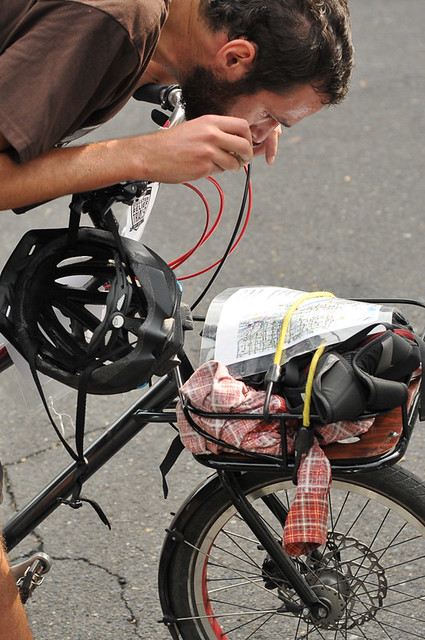
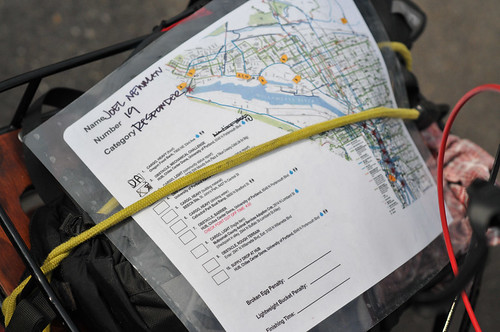

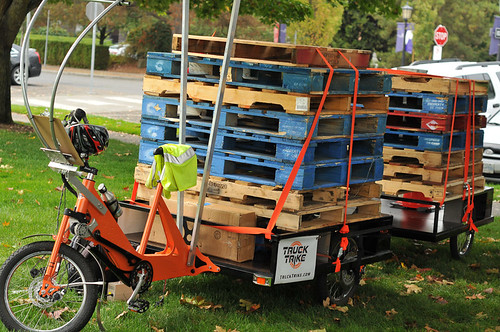
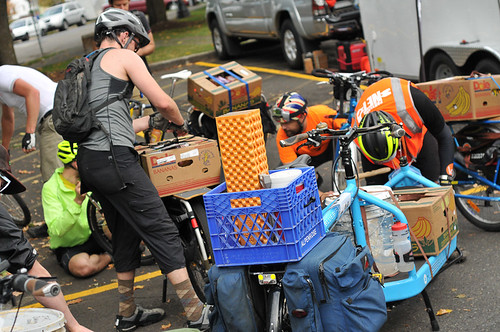
Advertisement



When the Big One does strike, Portland’s deeply rooted cargo biking culture, our respect for human-powered mobility, and the type of community building and skills on display at events like this will benefit us all. Thanks to all the participants, organizers, volunteers and sponsors!
Read more on this topic in our “bikes and disasters” archives.
— Jonathan Maus
jonathan@bikeportland.org
(503) 706-8804
@BikePortland


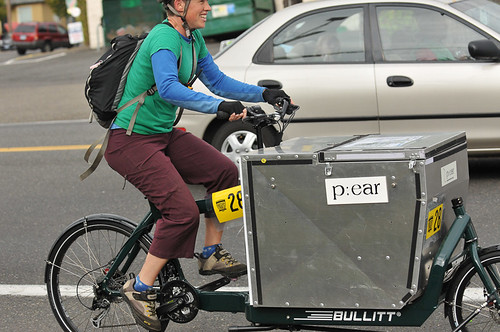
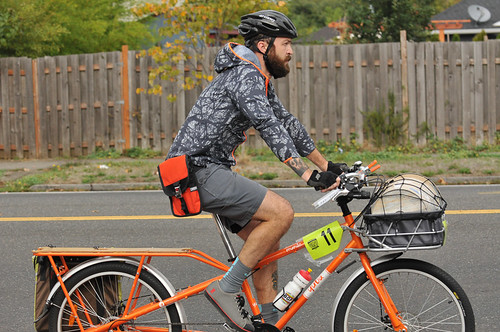

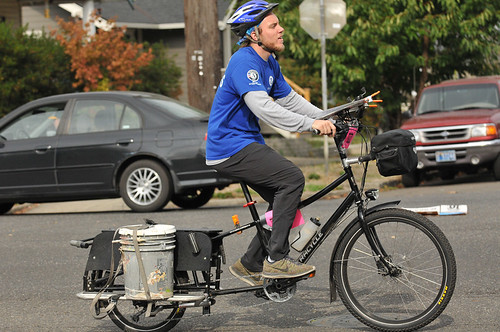



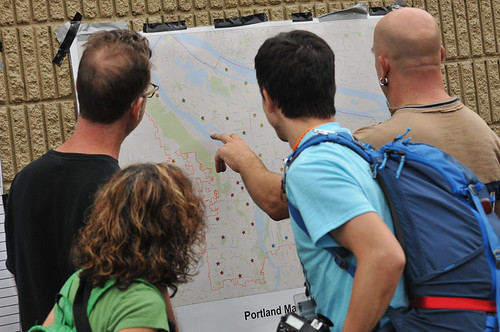
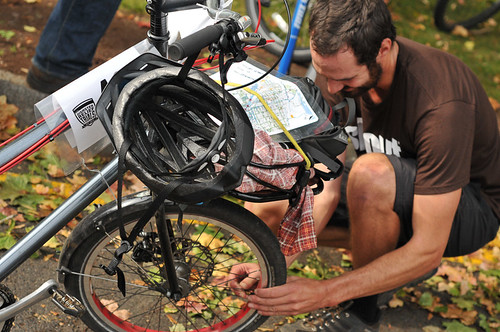
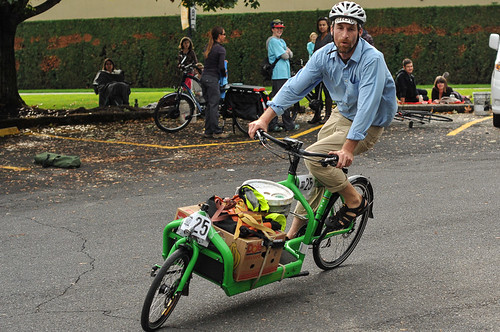


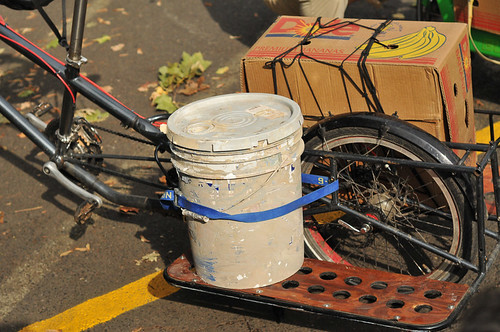

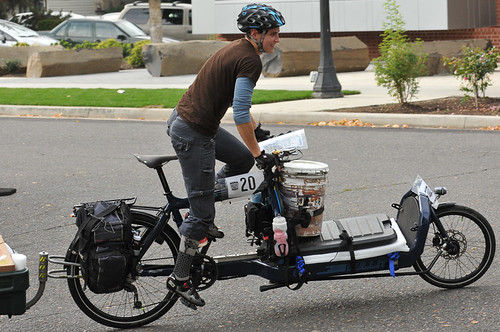
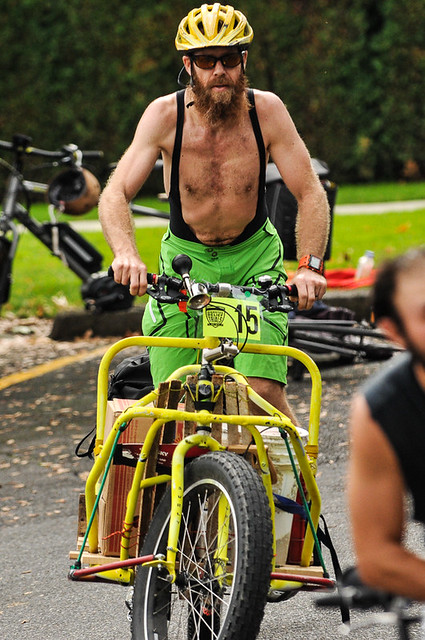







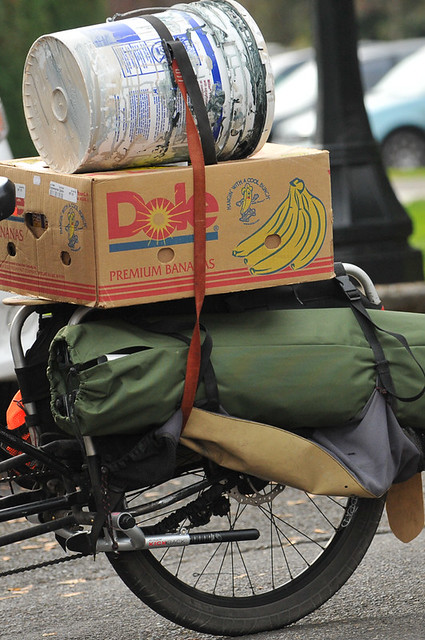
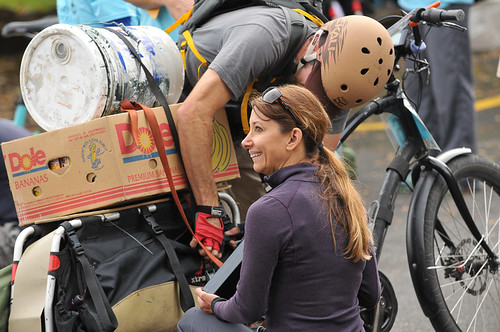
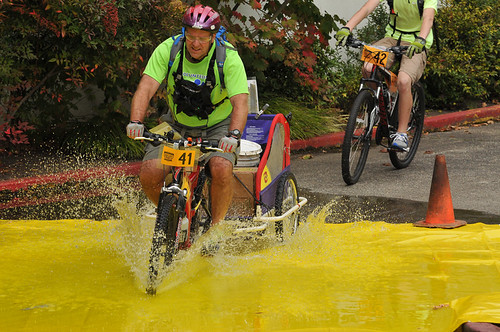







Thanks for reading.
BikePortland has served this community with independent community journalism since 2005. We rely on subscriptions from readers like you to survive. Your financial support is vital in keeping this valuable resource alive and well.
Please subscribe today to strengthen and expand our work.
Okay. Color me cynical. But with bridges down, fires raging everywhere, the west hills in downtown Portland, and downtown Portland sunk into the alluvium, all capped off by desperate survivors with kill or be killed mindsets, it’s gonna be bicyclists to the rescue? C’mon. The Big One won’t be another Columbus Day storm.
Such a downer Mike!
Let me ask you this: After the Big One, do you think moving around people and cargo will be important? Don’t you think a team of vehicles and responders that don’t rely on gasoline and that have practiced working together in a coordinated way will be useful?
If you answered yes, than don’t you think bicycles will be extremely valuable and potentially life-saving and helpful in many ways?
I certainly do.
Mike — your point about folks with “kill or be killed mindsets” is taken. However, this is not just about a one-day event with cargo bikes. The DRT, which I was happy to volunteer at, is the tip of a very large iceberg in which we LL have to find ways to greater resilience — and community connection.
I believe that building community with as many folks as possible reduces the risk of such a mindset.
Even for someone like me — older, slower, dependent on maintenance medication — there are still skills that can be acquired and steps that can be taken to be more prepared for a natural disaster.
I appreciate that this event was held in conjunction with an Emergency Preparedness Expo — another point at which citizens could come together to learn and share ideas and resources and get to know each other a little more.
We need MORE community-building gatherings like the DRT; and more opportunities to get out of our homes and meet our neighbors. We have two choices: sit on our hands and fret, or go outside and be useful in some way. I’ll choose the latter, to the best of my ability and resources. Cheers.
Kill or be killed?
Really? That is what you imagine this is going to be like?
O man, we have so much work to do.
http://bikeportland.org/2015/07/22/talk-disastrous-earthquake-got-just-keep-biking-151106#comment-6475915
You need to stop watching The Walking Dead. No earthquake has resulted in a Mad Max scenario. Look at the Chile, New Zealand, and Japan events.
Sheesh. No kidding, the post-apocalypse belief of “preppers” just blows my mind sometime.
Well, I guess they need a reason to stockpile 60,000 rounds of ammo and a small armory worth of guns now, amirite?
I was in the Alaska earthquake in 1964 (9.2 on the Richter scale). We had no water for weeks. We had no electricity for a long time, which meant no heat in March in Anchorage. Everyone looked out for each other. There was no “kill or be killed.” Heck, there probably wasn’t even any looting, which given the condition of downtown Anchorage, would have meant easy pickings. Human beings can be hideously cruel to one another, but we always seem to pull together when there’s a disaster.
This makes me happy 🙂
In the event of a disaster it’s the best for a community to stick together. I wonder if those who preach about how we need to ‘kill or be killed’ are creating a ghost of fear.
It’s really good to hear that. I’m a prepper myself, because I want to have a resilient household. It’s depressing to read the internet for tips, though, because the good information is buried in vast piles of paranoia and Apocalypticism. I don’t buy into lots of that (Obama’s not going to round up the Republicans and herd them into Walmarts for re-education), but there is some good info out there. It’s good to hear a real-life perspective.
Great photos!
and always fun to see trailers in amongst the cargo bikes.
Or the trailer with a cargo bike, which is handy for hauling a lot of bulk when you’ve got kids taking up most of the back of the longtail.
I love seeing all of these different setups and the hand-built bikes.
Hey that’s me!
What a great event. Really well organized and run. I had a great time. I think it leans more on the “fun” side than “realistic” but that doesn’t mean it isn’t worth doing. In fact, I hope we never have to do the realistic part.
It’s not entirely realistic, but it’s an exhibition, meant to bring attention to preparedness and get people thinking about transportation options after a disaster. Firefighters have competitions too, not because they expect to compete but to build camaraderie and hone skills via friendly competition.
As a NET team leader, I hope some of the DRT competitors will consider engaging with their local NET teams to either join up or to plan for how to act as a support role. A dozen cargo bikers in my neighborhood who knew where to show up and how to work with us would be a huge asset even if they were not trained NET volunteers. Maybe we can work that angle into next year’s DRT.
I don’t mean race checkpoints simulating NET operations – I think the existing race structure covers that fairly well. I mean that by the time somebody toes the line next year, if the live in Portland they should know the team leader and default staging area for their local NET.
Hold a “NET-bikes” event for a 1-day session to help riders get into the mindset of what they’d need to do or have for their specific rig, including ideas for how to secure things (and how much is too much), where to volunteer in the event of an emergency, a 1-mile obstacle course to try out what you learned.
I went to the QuakeFaire, and saw the tired riders coming in, and I honestly have no idea how they did it – but I have a BOB & am willing to help…
That’s actually the point Mike, these folks will already be prepared for the task at hand and will deal with the massive intangeables , chaos and challenges while many others wring their hands, panic and become paralyzed by inaction.
He’s got a point though; try getting a loaded cargo bike across the Banfield when all the local bridges are down…you might just be better off with a Brompton.
😉
The Tilikum and Sellwood bridges are robust and expected to survive quite a shake. The Disaster Relief Trials used the Tilikum bridge as forced routing to perform a west side community status report pick-up (all other bridges were declared unusable). But…the whole point of cargo bike relevance to neighborhood resilience is *neighborhood*. There are no neighborhoods that span the Willamette River. There are tons of infrastructure-invulnerable post-disaster relief assets located proximal to each and every neighborhood. With knowledge of these assets and knowledge of your neighbors and their dynamic needs, with a cargo bike and skills, lots of relief could be rendered when first responders are over-tasked and the transportation infrastructure is broken (fuel and passable roads).
I’m not talking about the Willamette River bridges, I’m talking about the local streets that cross I-84 on bridges.
And there are many more local street bridges throughout the city, most built prior to seismic building code requirements.
Neighborhoods don’t span freeways either. Maybe we should have a trial where they shake one of those viaducts down and see whether a cargo bike can cross there. For the river, we might need some kayaks or boats. It’s not going to be easy, but there probably won’t be any zombies.
Buzz: good point, I’m in agreement with you about broken overpasses providing lots of trouble. Cargo bikes and divisible cargo can navigate freeway landscaping. See my response that got pasted below.
The difference is they will try and accomplish great things while many of us standby and say it cant be done.
Eugene had an optional very challenging water crossing! https://instagram.com/p/88yzgdj8J6/
courtesy of ROTC
The Eugene water crossing was only optional for the family class. Every other class it was a required stop. They could opt out but would get a time penalty for it. I don’t believe anyone did.
Cute. Added incentive: the water is full of fecal matter; you don’t want to fall in.
The only thing that amuses me about some of the DRT rigs are the thinner tires – but of course, you equip for the CURRENT conditions and with the smoother roads we commute on they’re perfectly acceptable.
I was having the “big one” conversation with a few clients of mine a couple weeks ago and we had the “you can pilfer and loot” or the “you can work together to rebuild, prepare by getting involved with neighborhood emergency relief groups, have emergency food, water & basic essentials storage etc” – my clients, most of which have recently been released from prison after serving 10+ years, some military veterans, some having been involved in gangs or violent activity in their past – all agreed that it was [insert expletive here] to just go out and loot as it was more productive to work together as a team to rebuild the community.
Everyone should invest in some treaded 2″ tires and at least a midtail or work truck so they can do some off-road hauling when the road goes to crap. Keep family home storage (even if you’re a family of one! Don’t forget your pets and basic meds like aspirin have more uses than just pain relief)
And look into your neighborhood emergency relief group and getting certified for cpr/1st aid. You can choose to be selfish and go it alone or help your neighbor and work together to keep safe and pool resources.
If your rig has 20″ tires try street BMX tires. They are tough and the 2 inch or greater width lets you cross trolley tracks with insoucience. Available in the neighborhood at Goods BMX, 2808 NE MLK. (They do not pay me)
———
Was there really a five foot high obstacle?
Aaron Rogosin rode the race on his Cannondale (pictured). It’s the same rig he took on the Oregon Outback, and it faired very well even with his skinny tires. Not that I would trade in my fatties for his rig, but he does seem to be able to ride some pretty gnarly terrain on that thing.
Thank-you for the excellent coverage, Jonathan. I want to mention that DRT PDX 2015 would not have been executed with such professionalism (or at all?) were it not for the powerful leadership of Emma Stocker, a professional emergency manager and DRT Eugene co-founder, who now lives in Portland (lucky us!). Emma was the chairperson of our DRT Steering Committee. Alex Page, Rithy Khut, and Kelley Stangl provided vital work on the Committee as well. Jeff Rook, Environmental Safety Officer at University of Portland, was our University of Portlad liaison. Jeff is also steeped in the CERT world (Community Emergency Response Team). In Jeff, DRT PDX found the perfect partner for connecting our event to all the resources we needed: human and physical. We also had help from at least a dozen other people who really get the DRT concept. So grateful.
Can anyone tell me what kind of cargo bike
Jonna Papaefthimiou is riding in the photos? Thanks.
Looks like an eZee Expedir.
This was a great event, thanks to all of the organizers. This was our first DRT, but I’m involved with CERT, ARES/RACES and the Red Cross, and now after doing this event, I can see bikes are another tool in the preparedness tool box. My son and I had a fun time, took some learning and plan to do the DRT again next year.
What a great event! I had a great time spectating. Thanks for the article, Jonathan. It’s good to know the history and a bit more about the categories – and nice photos! I was impressed by the diversity of bicycles and the creativity with which they were rigged to haul cargo.
It’s possible that a bridge would be more or less intact but not passable by motor vehicles which weigh tons more than bikes.
I am always impressed each year with the development of this event. Way to go!
Perhaps for next year the “e-bike” category should have a “recharge” stop using solar power (X% recharge) – to simulate what would likely be needed to be done.
Good point. The Rough Terrain Checkpoint was *a really rough* 400 meters and the one meter barrier was set-up to be encountered with a load: double portage. This is to say: the DRT Essential Elements (11 of ’em) are designed to simulate total transportation infrastructure failure. I-84 will *always* be cross able. Cargo bikes can weigh as little as 55 pounds. With a buddy especially, there is no freeway landscape that can’t be crossed.
The Eugene one happened the same day and kicked butt as usual. It’s a real shame that the PDX folks took Eugene’s date so riders couldn’t do both like they’ve done for the past two years. The bigger city wins, I guess?
That’s some downer language. PDX “took” – as in stole? Check where it started before you start slinging mud. You might find it slinging back on you. If you found the date for Eugene unsatisfactory, get on the planning committee for next year so you can have a say in it. It’s really easy to get online and post a semi-anonymous random complaint on the internet but if you want it heard by the right people and be proactive about it; go to the source and get off your caboose. Being reactive will get you nowhere except pointed out that if anything Eugene “took” PDX’s date. disasterrelieftrials.com
Word is Eugene had the date months before PDX. I’m not looking to start a fight though. I think both events are great and all the organizers of both are great. I just wish I’d seen my PDX buddies down in Eugene this year. I think it’s unfortunate that PDX didn’t pick a different date since Eugene had this date months earlier. That’s all. It’s like when two friends schedule parties on the same day. It’s unfortunate.
I promise I don’t mean any ill-will.
(You do know they’re the same organizers right?) It’s a lot easier to get an event racked up with 1/4 the participants/volunteers/etc and set it aside while you work on the big show.
Seager,
We coordinated with DRT Eugene organizers re: date selection, making both of our events a “day 3 supply run” after the October 15 Great Oregon ShakeOut drill. The EUG and PDX organizers are pretty tight and mutually supportive. And yes, Eugene puts out the most excellent, most well-attended DRTs.
This seems like something fun to do with your 95 pound bicycle on a nice Saturday. IMHO it’s pure pipe dream that this motley fleet will have any practical value in any kind of disaster. Remember when cargo bikes were going to be a BIG help to UPS during the holidays? Yeah, like that. Eugene or Portland, this is fantasy as I see it.
So what are you doing that is ‘more realistic’?
As much as you probably hate to admit it, it’s gonna take big trucks and earth moving equipment to get things open and moving again. I don’t think you’ll be joyously pedaling around the rubble on a bicycle.
There are lots of people who think the real problems of the world all require a truck. Ha.
Many civilizations were built before trucks. And you don’t need slaves either. Ever heard of the Oregon Trail? No trucks.
Of course not. The person who shot me for my bicycle obviously will be the one joyously pedaling around the rubble.
This guy will get things back in order after the big shake-up:
http://www.lynnetteturnerparry.com/blog/wp-content/uploads/2014/03/truck.jpg
Not without 30 gallons of diesel, which is going to suddenly be in very short supply right about then, and we may prefer to divert to keep emergency generators running at hospitals.
Um: http://search.japantimes.co.jp/news/2011/03/13/news/rather-than-hoof-it-stranded-rush-to-buy-bicycles/
55 pounds, thank you very much! A 95 pound cargo bike would be a sad disaster relief bike indeed. I advocate for emergency management agencies to keep using all the traditional equipment and human resources *and* I advocate that neighbors prepare to help neighbors in the most efficient way possible…when roads are broken and clogged, communication is disabled, and gasoline is not available.
Right, cargo bike riders to save the world.
https://www.youtube.com/watch?v=nbm_4a4lO0Y
Let’s build Japan an Oregon Trail……absurd
Laugh all you want, Jerryw.
I wouldn’t count on fuel being trucked into our region for quite some time, never mind the potential for roads to be less than passable with, say, a car or truck. I’ll take my bike+trailer any day over your ____ to get around, haul things, help my friends, move water, food, equipment, etc. I already do that, and don’t see that this will not be a reasonable strategy once everything goes arse over teacup.
Cargo bikes to help save a neighbor.
Holy smokes all the negative mojo. Cargo bikes might be the only thing moving if larger machines cannot reload fueling stations. This reminds me of your typical suburbanite from somewhere not Portland saying, “Bikes are toys for kids or racing.” But now the commentary is slamming the amazingly utilitarian cargo bikes. My business delivers all of our coffee by cargo bike. We have made deliveries in the snow when cars are busy crashing or (wisely) staying home.
Nevermind a catastrophe… driving in this city at rush hour versus biking pretty much feels like armageddon to my soul anyway…it’s awful.